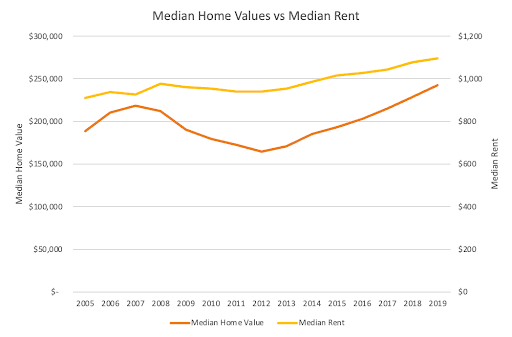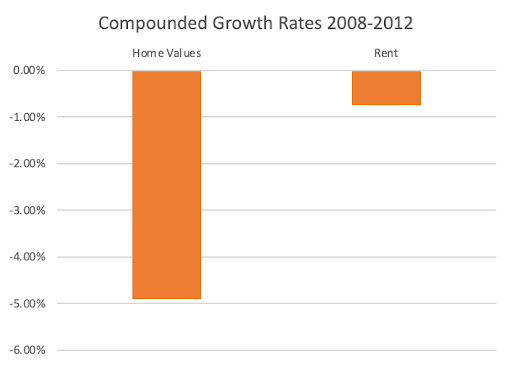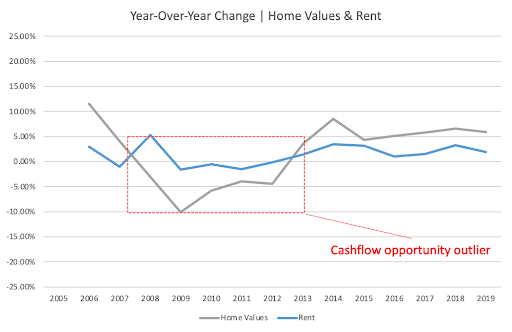The vast majority of real estate investors get into the industry to pursue passive cash flow. Unfortunately, over the last several years, finding deals with strong cash flow has become a challenge. However, there are still plenty of markets in the U.S. that continue to offer cash flow potential.
Below, I provide what I believe to be the top 10 markets in the United States for cash flow and offer a free excel spreadsheet you can download here that has key cashflow metrics for the largest 100 markets in the nation.
Cashflow Trends
There’s been a lot of anecdotal chatter about how difficult cash flow is to find these days, so I looked at the data to see if this is true.
One of the most common metrics used to estimate cash flow potential and the one I will use for the remainder of this article, is known as the rent-to-price ratio (RTP). The higher the RTP, the better potential for cash flow.
RTP is a simple calculation—you divide median monthly rent by median sales price. According to an analysis I did in 2020, there is a correlation of .85 (1 being the strongest correlation) between RTP and cash flow. It’s not perfect, but it’s pretty good for the broad analysis that we’re doing here.
As you can see, according to U.S. Census data, RTP has been on the decline since 2012. The chatter about cash flow becoming harder to find is accurate!
Rent-to-Price Ratio (2005-2019)
NOTE: U.S. Census data is not the most current, but it provides a consistent methodology over a long period and is therefore preferred for looking at historical data like this. For my analysis of what markets currently offer the best cash flow, I use BiggerPockets’ proprietary data, which is updated weekly.
This graph tells a very important story about the Great Recession’s impact and its subsequent fallout when housing prices dropped significantly more than rent prices.
Generally speaking, during recessions, rent values don’t fall very much. Demand from renters does not fluctuate much based on economic cycles. People will always need a place to live. In fact, home prices don’t usually dip too much during recessions either – with the Great Recession being a notable exception.
 Median Home Values vs Median Rent (2005-2019)
Median Home Values vs Median Rent (2005-2019)
From 2008-2012, home prices declined more dramatically and for longer than rent.
You can see this very clearly if you look at the compounded growth rates for the years 2008-2012. Home values averaged a decline of nearly 5% per year for four years while rent was negative, but barely.
 Compounded Growth Rates for Home Values and Rent Prices (2008-2012)
Compounded Growth Rates for Home Values and Rent Prices (2008-2012)
This created the ideal situation for the cash flow we saw in the aftermath of the Great Recession. Homes became cheaper, and expenses declined, but incomes stayed relatively flat. Since 2012, home values started growing faster than rent, and RTP started to decrease.
So, while it’s true that cash flow has been, on a national level, increasingly difficult to find, it’s important to remember that the Great Recession and its aftermath was a uniquely positive opportunity to find cash flow. It’s not the norm.
 Year-Over-Year Change for Home Values and Rent (2006-2019)
Year-Over-Year Change for Home Values and Rent (2006-2019)
That said, there are still good opportunities to find cash flow! Certain markets still offer excellent cash flow prospects across the board, and most markets can still produce cashflow if you pursue value-add strategies, short-term rental, or other creative strategies.
For this analysis, I looked at which markets offer strong cashflow potential regardless of strategy, as measured by the rent-to-price ratio.
Top 10 Market for Cashflow in 2022
Broadly speaking, the best cashflow opportunities in the United States are concentrated in the Midwest and Southeast. If you look at the interactive map below, you can see none of the markets are west of Louisiana. Again, that doesn’t mean you can’t find cash flow in other cities. But generally speaking, the western half of the county has less cash flow opportunity than the eastern half.
Here’s the data for the top 10 cashflow markets:

As you can see, Detroit stands on its own in terms of cash flow, with an RTP more than double the next highest city on our lists. Regardless, all of the cities on this list offer strong cash flow potential.
You should note that I didn’t just pick the 10 cities with the highest RTP. I didn’t want to concentrate on all the interesting markets near each other, so I tried to create some geographic and economic diversity amongst the cities (I still couldn’t find anything in the west). I also only chose cities that have enough data for analysis and large enough economies to warrant investing consideration.
You can download my summary data here to see the data for the largest 100 cities in the U.S.
How To Interpret This Data
If you’re looking at this list or the spreadsheet thinking, “what is a good RTP?” That’s a great question! That is a personal choice for investors, but I’ll share my thoughts.
For many years a lot of investors subscribed to something known as the 1% rule. It basically stated that any deal you pursue should have an RTP above 1%. Furthermore, some people only want to invest in markets where the average RTP is 1%. Personally, I don’t subscribe to this rule for a few reasons.
- It was developed over a decade ago during the cashflow outlier period I mentioned above. It was realistic back then to find plenty of deals with an RTP over 1%. Now, it’s no longer a useful rule of thumb. You need to adjust to current-day market conditions, and religiously following the 1% rule is going to prevent you from getting in on deals that are very strong by today’s standards. Some of my best deals, even my highest cash-flowing deals, didn’t meet the 1% rule at the time of purchase.
- RTP is just a proxy for cash flow—not a precise measurement. You shouldn’t decide to pursue or abandon any deal until you’ve fully run the numbers. RTP alone should not be used to make investing decisions. You need to account for taxes, insurance, and other expenses. Additionally, you need to factor in rent growth. If rent grows in your market, the RTP will improve over time.
- I love using RTP to screen markets for cashflow potential but remember the data above is just the average. That means, by rule, there are deals with better RTPs than the city’s average and deals with worse RTPs than the city’s average. For example, in Milwaukee, the average RTP is 0.7%, but I guarantee committed investors can find deals with a much higher RTP than 0.7%, and likely even above the 1% rule. Generally speaking, any market with an RTP above .6% has the potential for cashflow deals.
Conclusion
Although cash flow potential, as measured by RTP, has declined over the last several years, many markets in the U.S. still offer strong cash flow potential across the board. As my analysis shows, they are largely concentrated in the Midwest and Southeast. But that being said, plenty of other markets offer cash flow potential. I encourage you to download the spreadsheet accompanying this article and conduct your own analysis.
And remember, this data is just averages! It doesn’t reflect the best possible deal in each city, it doesn’t factor in rent growth or value add either. These are broad metrics meant to help you narrow down cities for investment consideration. They are not meant to evaluate the potential of any individual deal or sub-market.
On The Market is presented by Fundrise

Fundrise is revolutionizing how you invest in real estate.
With direct-access to high-quality real estate investments, Fundrise allows you to build, manage, and grow a portfolio at the touch of a button. Combining innovation with expertise, Fundrise maximizes your long-term return potential and has quickly become America’s largest direct-to-investor real estate investing platform.
Learn more about Fundrise
How are you finding cash flow in today’s market? Let us know in the comments below.
Note By BiggerPockets: These are opinions written by the author and do not necessarily represent the opinions of BiggerPockets.

